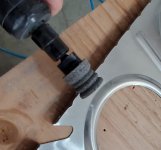Hello,
New builder with little practical experience. I'm setting up my shop and starting the practice tool box. I have a bench grinder(6" scotch brite), a file from clevland tools and the scotch brite pads. I've found that deburring on the grinder is a good way to ruin parts if you have little experience like me and i'm looking for advice.
I deburred the sides of toolbox, but the mistakes i've made so far have me worried about using the grinder for the toolbox lid and body. Any advice or pointers to videos would be appreciated. Thanks.
New builder with little practical experience. I'm setting up my shop and starting the practice tool box. I have a bench grinder(6" scotch brite), a file from clevland tools and the scotch brite pads. I've found that deburring on the grinder is a good way to ruin parts if you have little experience like me and i'm looking for advice.
I deburred the sides of toolbox, but the mistakes i've made so far have me worried about using the grinder for the toolbox lid and body. Any advice or pointers to videos would be appreciated. Thanks.





